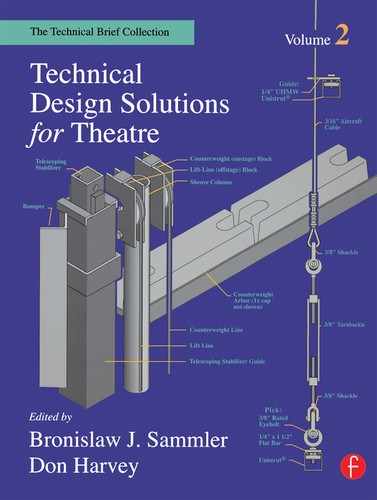Theatrically Safe Outdoor Bonfires |
Ashley Elder |
I’ve always fancied myself a good campfire builder, but I never thought I’d put this skill to use in the theatre! For The Bread Loaf Theater’s recent production of Shakespeare’s Henriad series, our designer asked that each show include six large outdoor bonfires. The shows were going to run for 12 days straight in rotating repertory, and every show involved bonfires at some point. In each show, both actors and audience members were close to the fires when they were lit and while they burned. The fires were burned in 5′ tall braziers, which were used in different locations each night. The huge fires were to be started by an actor carrying a torch and had to instantly ignite. Once lit, the fires needed to burn brightly for 45 minutes, at which point they were extinguished. The fires were untouched for at least 15 minutes prior to being ignited, which meant that any accelerant used needed a low volatility so it didn’t evaporate, or cause an explosion when lit. The fires needed to be predictable, light immediately in wind or rain, and be safe for actors and audience — in short they needed to be everything fire usually isn’t!

FIGURE 1: THE BONFIRE
The solution, after many hours of trial and error, culminated in the following recipe for the perfect fire. The braziers were made of steel mesh wrapped into a shallow cone, onto which square tube steel legs were welded. We then ripped down 1×4 to ¾″ × ¾″ × 8″ sticks. These were placed in the brazier oriented like petals on a flower radiating out from the center. We placed them close enough to block nearly all airflow to the fires from underneath.
Making fire burst safely and reliably into flames is difficult. In our early experiments, the accelerant either evaporated, caused a giant fireball, or didn’t burn hot enough to light the wood. The solution was to fold a 36″ × 48″ piece of butcher paper into quarters and form it into a bowl by rolling the outside edges inward. The bowl, 4-paper-layers thick, was placed in the brazier and filled about a third full with charcoal lighter fluid. Once it had become completely saturated, the paper held a reservoir of the lighter fluid. With fewer than four layers, the bowl burned too quickly, and the lighter fluid fell out of the bottom of the brazier, creating a flaming puddle.
The bulk of the fires’ fuel was birch kindling and logs. We experimented with pine, oak, cherry, and maple logs, but settled on the birch because it exploded the least, lit the easiest, and burned sufficiently long and brightly. It was crucial for the kindling and logs to be thoroughly dry and seasoned. Unseasoned logs were a complete failure. The best results were achieved when approximately twelve 1″ thick kindling pieces were laid in a brazier, all oriented in the same direction with a few birch logs placed on top.
After adding the logs, the entire assembly was given a thorough dousing of lighter fluid. The lighter fluid tended to run off the logs and drip onto the ground, which would be problematic if burning embers fell from the fire into the flammable puddle. Therefore, before the final dousing each night, we laid a scrap of plywood under the brazier to catch drips of accelerant. Once the braziers had finished dripping (about 60 seconds), we removed the plywood and placed a metal bowl, about 12″ in diameter with 2″ of water, under the brazier to extinguish any of the larger embers that might fall. The plywood, now soaked in lighter fluid, was removed from the area and placed flat on the ground, damp side up, to dry safely.
In addition to careful assembly, we took a few more safety precautions. Each night we thoroughly hosed the ground around each brazier. Also, there was a fire attendant standing inconspicuously near each fire with a fire extinguisher filled with water and a wet towel. In the unlikely event that a spark landed on an actor or audience member’s clothing and began to singe, it could be easily and undramatically extinguished with the wet towel.
All in all, the fires were a huge success. They were predictable, reliable, and safe.
